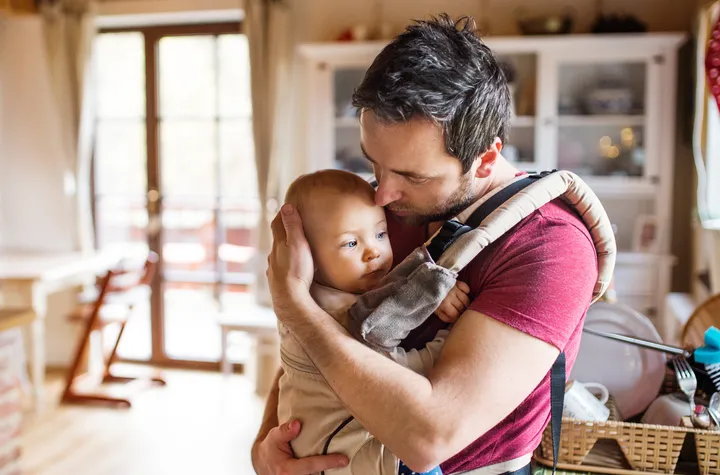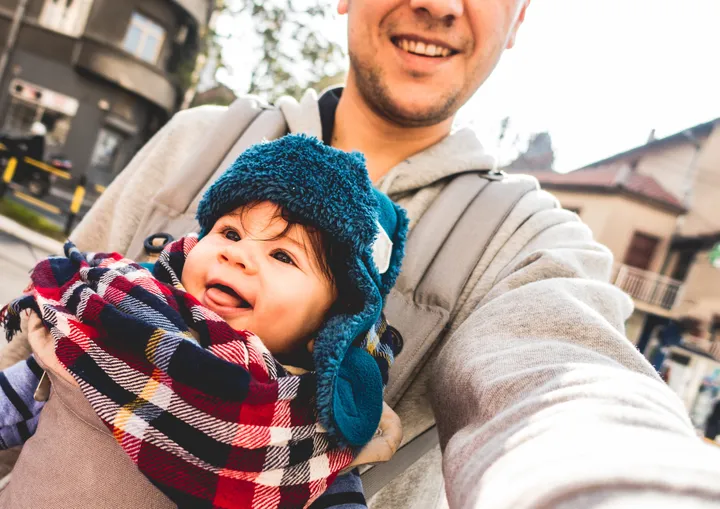I’m A Dad-To-Be With A Disability. Here’s Why I’m Learning To Carry A Baby Months In Advance.
Aaron Broverman | HuffPost, February 25, 2020
Most dads don’t give carrying their kids this much thought and effort. But I have cerebral palsy.
I put both arms into the Baby Bjorn and flipped it over my head, the way a preschooler puts on a jacket. I clipped the carrier’s back pad around my midsection. When time came for the baby, I cradled its head with my left arm, and reached my right hand underneath. I lifted — slowly, slowly — wondering how much harder this would be with a live infant. I settled the toy doll into position, exhaled and began securing the harnesses.
I looked down and checked my work. I’ve crushed the baby’s legs. Deep breath. I took the baby carrier off and started over again. Would I ever be able to carry a child for real? At the time, I had just under three months for my daily practice to start paying off.
That’s when our firstborn is due.

Most dads-to-be don’t give the prospect of carrying their kids this much thought and effort — they don’t have to, they just do it. But I have cerebral palsy, which affects my balance, mobility, dexterity and coordination.
Carrying something like a coffee cup and keeping it level is simple for me. I can hold it as hard as I want to, and it won’t squirm away. But a latte does not have a mind of its own. Replace that coffee with a heavy baby in a bad mood, and they (or both of us) are likely to go plummeting to the floor.
To complicate matters, my hands are occupied most of the time with the set of forearm crutches I use when I walk outdoors. I can push a stroller short distances using them, sure, but for longer trips I require a mobility scooter. I can’t drive and hold a baby at the same time.
“It makes me feel like I need to be even more prepared than the average parent.”
Hence, the carrier. I want to be the independent dad I envision myself becoming, one as much a part of my child’s infancy as their later years.
At this point you might be asking, “Why are you doing all this?” If carrying my kid was so potentially dangerous, why don’t I just let my wife do the literal heavy lifting?
My wife will be able to help while she’s on maternity leave, but eventually she’s going back to work. As a freelance writer, there will come a time when I’m going to be home alone with the kid. I refuse to be anything less than ready for it.
Parents with disabilities also receive more scrutiny. It makes me feel like I need to be even more prepared than the average parent. Carrying my kid shows I have a system for parenting, and if others see a confident dad when they look at me, maybe I will feel more confident in myself.
‘It showed me carrying my kid was possible’
I knew for a while that I would have to practise to feel confident holding a baby. The last time I tried, I was like the 1966 Adam West Batman running with a bomb — I couldn’t get rid of it fast enough.
At first, I had briefly imagined wheeling around our unadapted condo apartment in a manual wheelchair, baby on my lap. My wife Brittany argued a carrier was more suited to my capabilities, so to be sure, I registered for a parenting with a disability conference.
Just knowing that carriers were the go-to for other parents with disabilities lifted a huge weight from my shoulders. It showed me carrying my kid was possible, and that I wouldn’t have to give up my independence to parent.
“I didn’t even use a stroller,” said one woman at the seminar who used a mobility scooter like the one I had. “I just put the kid in the carrier and just rode the scooter with the kid strapped to my chest.”

Warming up to the idea, I figured I could use some hands-on experience. I later reached out to the Centre For Independent Living Toronto – a peer-run organization helping people with disabilities lead more independent lives. They put me in touch with Carry Me Close Babywearers, an inclusive group of Toronto-based advocates who run baby-wearing 101 meetings. I signed up.
It was a relief to hear that many of the moms and dads in the class had the same questions I did. A dad raised his hand. “Where should the child’s legs be?” In frog position, forming a kind of “M” shape around your body. “What about the arms?” Depends on the carrier and the baby’s comfort. (In my case, out and over the back flap).
“I learned I had nothing to fear, that parenting independently was possible.”
It seemed like many of the parents had the luxury of carrying their kid in their arms if they wanted to, but the time and energy they invested into using a carrier put us on relatable footing. Learning alongside them was a good reminder that everyone needs assistive devices sometimes, even when it isn’t a way of life.
The key confidence booster, however, was practicing with a weighted baby doll that approximated the real thing under the watchful eye of people who had once been in the same position I was in. I learned I had nothing to fear, that parenting independently was possible — and, for what it’s worth, that it would be fairly difficult to accidentally kill a child in a baby carrier mishap. (Phew.)
I could now picture myself walking around my condo, child on my chest. My balance was fine as long as I used crutches. On a scooter, my hands were free enough to drive, and the carrier didn’t obstruct my view.
It seems my practice has paid off.
About This Article:
A Life Worth Living has copied the content of this article under fair use in order to preserve as a post in our resource library for preservation in accessible format. Explicit permission pending.
Link to Original Article: https://www.huffingtonpost.ca/entry/dad-with-disability-baby-carrying_ca_5e4ff985c5b6a4525dba7080

